A look into the regulation of e-scooters
Parking Policies
One main issue with dockless mobility is parking. By their very nature, E-scooters can be parked virtually anywhere. In general, these forms of mobility can be hazardous if parked incorrectly. Parking E-scooters on the sidewalk has led to problems in cities throughout the U.S. and has even led some cities to consider parked E-scooters a public nuisance. In San Diego private citizens have lobbied for E-scooter regulation to prevent injuries to pedestrians as a result of irresponsible E-scooter use. Even in Columbia S.C., there is a fear that the use, and incorrect parking, of E-scooters, can lead to the loss of business in certain areas.
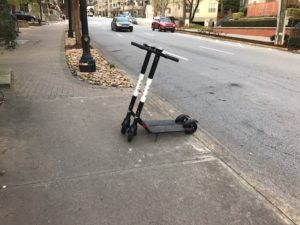

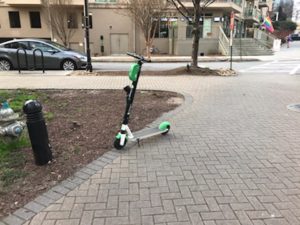


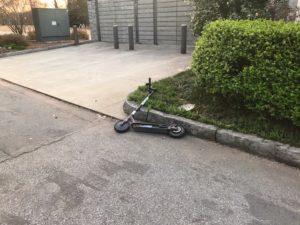

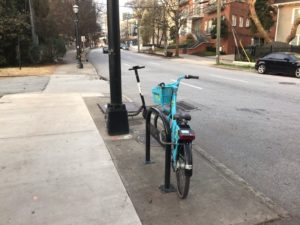
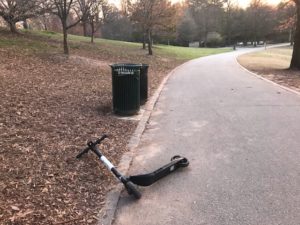
Scooter Parking in Atlanta, GA
What are some of the solutions to E-Scooter parking?
- Designated Parking Areas
- Autonomous Mobility Units
- Public enforcement through manufacturer- community watch
- Geofencing
- Community Education
- Local Law Enforcement
A detailed description of each solution, along with implementation factors, strengths/ weaknesses of the specific solution, and links to more information, is located below.
__________________________________________________________________________
Solution 1: Designated Parking Areas
Summary:
- Create Designated Parking Areas for dockless mobility vehicles.
Detailed Description:
Some cities have addressed the dockless mobility parking issue by creating designated dockless parking areas. Dockless mobility users must place their dockless vehicles in these areas or face possible fines. These parking spaces are usually in high foot traffic areas where individuals would likely take a dockless vehicle. Cities have converted car parking spaces or sidewalk space into dockless mobility spaces. Municipalities hope that with these designated areas there will be fewer safety concerns with dockless mobility vehicles caused by incorrect parking, such as in the middle of the sidewalk or street.
Implementation:
Municipalities will need to determine where and how to implement these parking spaces
Nice Ride Minnesota has a public parking zone plan for dockless bikes that may be helpful for municipalities as they decide where to place dockless mobility parking areas. Parking Zone Master Plan
Municipalities may want to consider placing the burden of creating/ placing designated parking areas on the dockless mobility providers and require providers to create these parking areas.

Designated Bike Parking in Seattle WA
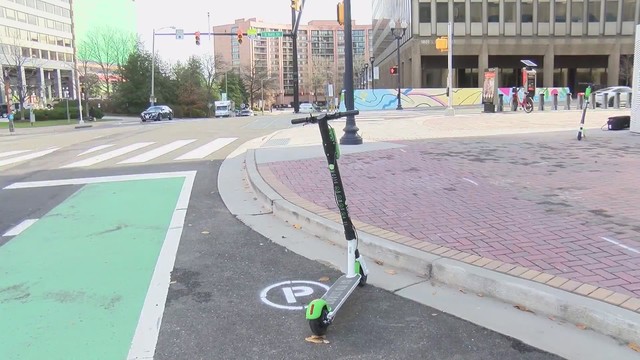 Designated Scooter Parking in Arlington VA
Designated Scooter Parking in Arlington VA
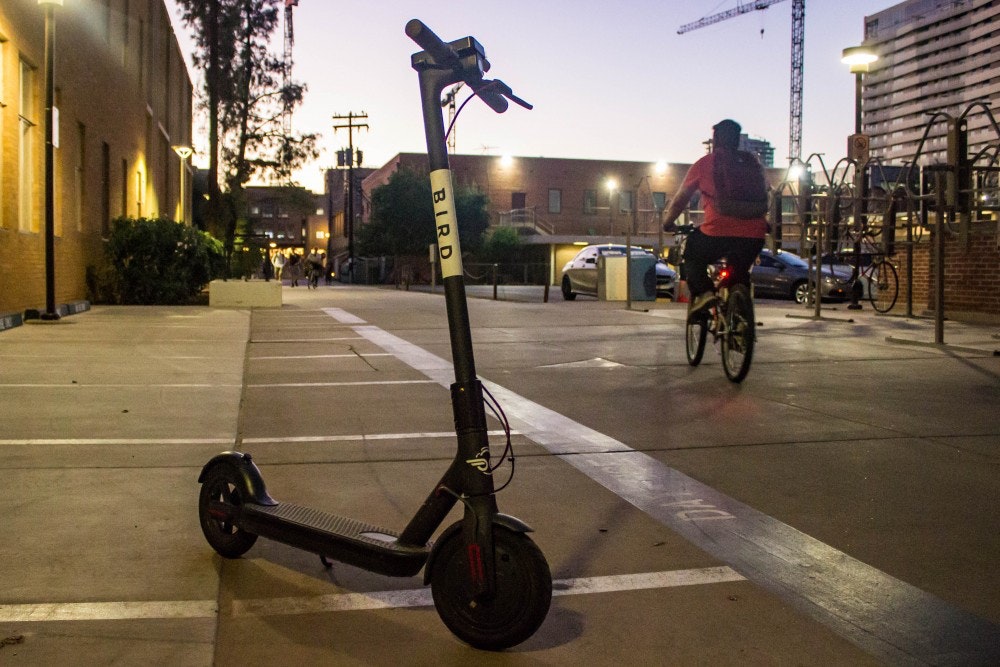 Arizona State University Campus
Arizona State University Campus
Strengths:
- Low cost
- Easy implementation
Weaknesses:
- Need space for parking
- Need users to know about Parking Areas/Educate users
Where to find more information:
__________________________________________________________________________
Solution 2: Autonomous Mobility Units
Summary:
- Use of new technology to allow mobility units to return to a designated area on their own power.
Detailed Description:
Admittedly this solution is not active yet, but it is on the horizon. E-scooter companies, such as Uber, have announced that they are working on autonomous, or self-driving, versions of their dockless bike and scooter models. These developing vehicles will drive themselves to locations where riders need them, or to places where the vehicles can be charged. This technology could eliminate parking issues by forcing dockless vehicles to go to designated areas after a user has finished their trip. Also, this technology could help eliminate driving issues by guiding riders to their destinations with ease.
Implementation:
This technology will likely not be available for public use for the next 2-10 years, but if and when it does become available it may have a significantly positive effect on E-scooter parking. As this technology becomes readily available, municipalities may consider requiring dockless mobility companies to use this technology, as a stipulation of granting companies the right to operate within city limits.
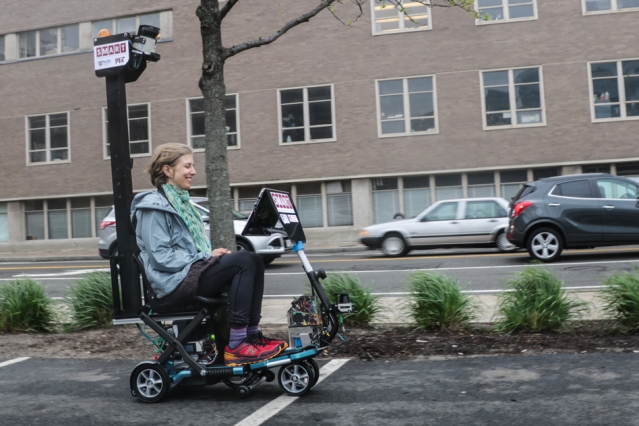
Strengths:
- May eliminate human parking error
- Lower enforcement needs
Weaknesses:
- Expenses – new tech
- Possible liability issues
- Maintenance
Where to find more information:
__________________________________________________________________________
Solution 3: Public Enforcement Through Provider based on Community Watch
Summary:
- Rely on Providers to discipline users for improper use of dockless mobility, as well as take care of dockless mobility units that are placed in the wrong areas
Detailed Description:
Some dockless mobility Providers have created apps that allow the public to report misuse of the Provider’s devices directly to the provider. These apps allow the user to take pictures of the violation and send photos to the Providers, as well as send messages to the Provider.
Scooter Provider Bird has specifically asked for people to report poorly parked scooters so they can send workers to position scooters to a better parking area. To report a poorly parked scooter a person needs to click on Community Mode in the Bird app and write about the issue and send an exact location. Also, Bird requires riders to take photos when a rider parks a scooter. If Bird receives a picture of a poorly parked scooter from a rider, it will then send the rider targeted safety education and also send a worker to place the scooter in a better location.
If an Provider recovers too many complaints or bad pictures from riders, they can shut down a user’s account. This may be a valid way to enforce local laws and ordinances that are placed on dockless mobility. Municipalities may be able to require dockless mobility Providers to implement local ordinances through their app instead of through the use of local law enforcement.
Implementation:
Municipalities will need to rely on the Provider to develop and distribute the app, but municipalities may need to ask for updates and data access from the Provider to determine what ordinances are being enforced.

Strengths:
- Would likely be very useful because of the use of apps and control for starting the scooters
- Would allow less work on Police and Public services
Weaknesses:
- High cost
- Would place a burden on Providers- which may lead to Providers not setting scooters in a city that requires this solution
- Would also require citizens to report the issues they see, many would likely not know of rules if they are not educated on scooter rules
Where to find more information:
__________________________________________________________________________
Solution 4: Geofencing
- The use of geolocation technology to limit the areas in which dockless mobility can operate.
Detailed Description:
Some cities have started to place geofence zones to guide dockless mobility use. A geofence zone is defined by a GPS or RFID tag, which, when connected to a mobile device, registers when a bike or scooter leaves a specific zone. Geofence technology has been used to cut off electric scooter and bikes from operating in specific areas. The geofencing systems will alert the Provider of when a bike or scooter goes into an unauthorized zone, and the geofencing technology can then cut off the bike or scooters motor, not allowing the user to operate the device in a specific area. A geofence platform controlled by a city or Provider would enable the city or Provider to set clear rules and boundaries for dockless mobility use, with little oversight, once in operation.
Implementation:
Five steps are needed for a municipality to implement a geofence:
- Build a plan – official will need to build a plan for where they want to limit dockless mobility operation
- Create the platform– find a software provider, or create a platform in which the geofence can be monitored.
- Find Providers– Fine dockless mobility providers that are willing to fall in with the use of geofence
- Implement technology with Providers– this step will require a large amount of communication between the municipality and the Provider.
- Monitor, adjusting and optimizing– The geofence will need to be monitored and adjusted based on multiple variables, including enforcement and use

Strengths:
- Little monitoring required once the system is in place
- Creates a barrier of protection for pedestrians
Weaknesses:
- High upfront cost
- High maintenance of tech system
- Users may still find ways to misuse mobility
Where to find more information:
__________________________________________________________________________
Solution 5: Community Education
Summary:
- Create programs that educate the public on the correct use of dockless mobility and require education for use.
Detailed Description:
Some municipalities and Providers have created community education plans to help inform the public about dockless mobility, its safety, use, and interaction with the local transportation system. One decision that will need to be made by communities and Providers is who will be responsible for educating the public the correct use of scooters. Some Providers have already taken it upon themselves to inform riders even before they use a form of dockless mobility though required pre-training on their app platforms.
Implementation:
Municipalities, or Providers, will need to develop this training in a way that is easily absorbed not only by riders but by the public at large, as dockless mobility affects the community at large. Cities like Austin TX have even developed websites to help inform the public of the correct use of dockless mobility.

 Austin Dockless Mobility Public Education
Austin Dockless Mobility Public Education
Strengths:
- Lower cost than some of the tech alternatives
- Would allow users and the public to learn
Weaknesses:
- It will take time for the information to disseminate
- People don’t have to follow the rules
- Who is going to educate, the mobility companies or the municipality?
Where to find more information:
__________________________________________________________________________
Solution 6: Local Law Enforcement
Summary:
- Use local law enforcement officers to enforce dockless mobility regulations, such as parking.
Detailed Description:
Municipalities may rely on law enforcement officers to enforce dockless mobility regulations. However, this type of enforcement may place an undue burden on law enforcement, by taking away officers from more pressing duties. Municipalities may want to create special groups under parking enforcement to combat dockless mobility misuse.
Implementation:
Train officers in local regulation, and what possible punishments could be used to stop the incorrect parking of dockless mobility.


Strengths:
- Allows local officers to build relationships with the community
- Places control on local government to monitor issues
Weaknesses:
- It will take time to train officers on rules and regulations
- Officer’s time could be used for more critical issues
- Arguably would cost significant funds
Where to find more information:
__________________________________________________________________________
Parking Legal Language Example
To help with Legal language construction here is an example based off of Atlanta’s E-Scooter Regulation
(a) The City reserves the right to identify E-scooter parking areas and non-Parking Areas.
(b) Providers must communicate proper E-Scooter parking requirements to all users.
(c) E-scooters shall be parked upright.
(d) No person shall park an E-Scooter other than upon the sidewalk, in a bike rack, or against a building or at a curb (and not on/ in any area identified in (e)), in such manner as to afford the least obstruction of pedestrian traffic and provide a minimum of 5 feet clearance for pedestrians.
(e) E-scooters shall not be parked
1) On vegetation;
2) On any grate, utility hole cover, or access lid;
3) In any loading zone, driveway, vehicle travel lane, bike lane, or shared-use path;
4) Where they obstruct vehicle parking;
5) Where it obscures any fixed, regulatory, or informational signs or traffic control devices;
6) Where it obstructs emergency service infrastructure including but not limited to fire hydrants or Automated External Defibrillators.
(f) All E -Scooters shall have permanently affixed contact information and Provider specific device identifiers on all E-Scooters for relocation requests. Providers must monitor and document relocation requests and responses 24/7.
(g) Providers will remove improperly parked E-Scooters in accordance with local laws. If an E-scooter is improperly parked the City reserves the right to cite, impound, and dispose of the Improperly parked E-scooter at the Providers’ expense.
